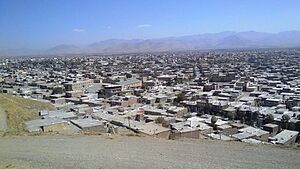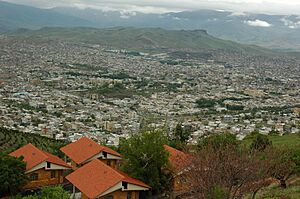Iranian Kurdistan facts for kids
Iranian Kurdistan or Eastern Kurdistan is a special name for parts of northwestern Iran. This area is home to many Kurds. It includes provinces like West Azerbaijan Province, Kurdistan Province, Kermanshah Province, and Ilam Province. Some parts of Hamadan Province and Lorestan Province are also included.
About 10% of Iran's total population are Kurds. In 2006, the main Kurdish areas in Iran had about 6.7 million people. Kurds often see northwestern Iran as one of four main parts of a larger area called Greater Kurdistan. The other parts are in southeastern Turkey (Northern Kurdistan), northern Syria (Western Kurdistan), and northern Iraq (Southern Kurdistan).
Far from Iranian Kurdistan, about 1000 km away, there's another group of Kurds in northeastern Iran. They are called the Kurds of Khorasan. They speak a different Kurdish language called Kurmanji, unlike the Kurds in western Iran.
Contents
A Look at History
Early Kurdish Rulers
From the 900s to the 1100s AD, two Kurdish families ruled this region. They were the Hasanwayhids (959–1015) and the Ayyarids (990–1117). Their lands included places like Kermanshah and Ilam.
Later, in the early 1300s, the Ardalan state was formed. It controlled areas like Zardiawa, Khanaqin, and Hawraman. Their first capital city was Sharazour, in what is now Iraqi Kurdistan. But it later moved to Sinne (Sanandaj) in present-day Iran. The Ardalan family ruled until 1867, when the Qajar king Nasser-al-Din Shah took over.
Seljuk and Khwarazm Periods
In the 1100s CE, a ruler named Sultan Sanjar created a province called "Kurdistan." It was centered near Bahar, northeast of Hamadan. This province included cities like Hamadan, Dinawar, and Sanandaj. Sanjar's nephew, Sulayman, ruled it.
In 1217, Kurds from the Zagros mountains defeated the army of Ala ad-Din Muhammad II. He was the king of the Khwarazmian dynasty, and his troops were sent from Hamadan.
Safavid Era
The Safavid family, who later ruled Iran, originally came from Iranian Kurdistan. They moved to Azarbaijan and settled in Ardabil around the 1000s CE.
During Safavid rule, the government wanted to control Kurdish areas in western Iran more tightly. At that time, there were several semi-independent Kurdish groups, like the Mukriyan (Mahabad) and Ardalan (Sinne). The Kurds wanted to keep their self-rule, which led to many fights with the Safavids.
After the Kurds were defeated, the Safavids decided to move many rebellious Kurds away from their homes. This policy started under King Tahmasp I (who ruled from 1514–1576). Between 1534 and 1535, Tahmasp I destroyed many old Kurdish cities and villages. Large numbers of Kurds were moved to the Alborz mountains and Khorasan in central Iran. Even an ancient Kurdish tribe, the Hadhabâni, was moved from central Kurdistan to Khorasan, where their descendants still live today.
The Safavid era was important because it helped connect Iranian Kurdistan more closely to the main government of Iran. Kurdish leaders at the time felt a strong connection to Iran, which helped shape Iran's western border.
The Battle of DimDim
There is a famous historical story about a long battle in 1609–1610 between Kurds and the Safavid Empire. This battle happened around a fortress called Dimdim near Lake Urmia in northwestern Iran.
In 1609, Emîr Xan Lepzêrîn, the ruler of Beradost, rebuilt the ruined Dimdim fortress. He wanted his growing area to stay independent from both the Ottoman and Safavid empires. Rebuilding Dimdim was seen as a move towards independence that could threaten Safavid power. Many Kurds, including the rulers of Mukriyan (Mahabad), joined Amir Khan.
After a long and bloody siege, Dimdim was captured in the summer of 1610. All the defenders were killed. Shah Abbas ordered a large killing in Beradost and Mukriyan. He then moved the Turkish Afshar tribe into the area and sent many Kurdish tribes to Khorasan.
While Persian historians saw this battle as a Kurdish rebellion, Kurdish stories and poems, like Beytî dimdim, remember it as a fight for freedom against outside control. Beytî dimdim is considered a national epic, almost as important as Mem û Zîn by Ahmad Khani.
Afshar Period
When the Afghans invaded the Safavid lands in the early 1700s, the Kurds took advantage of the situation. They took over Hamadan and moved close to Isfahan. Nader Shah tried to stop a Kurdish rebellion in 1747, but he was killed before he could finish. After Nader's death, Kurdish tribes used the power vacuum to capture parts of Fars.
Qajar Period
In 1880, a Kurdish leader named Shaykh Ubaydullah led several revolts against the Iranian government. The Qajar kings successfully stopped these revolts. In the early 1900s, Ismail Agha Simko rebelled against the Iranian government after World War I. He was eventually defeated by Reza Shah Pahlavi.
Kurds in Modern Iran
Simko's Revolts Against Reza Shah
The Iranian government was weak during World War I. This encouraged some Kurdish leaders to take advantage of the situation. Simko Shikak, a tribal chief, took control of the area west of Lake Urmia from 1918 to 1922. Another leader, Jaafar Sultan, controlled the region between Marivan and north of Halabja until 1925.
In 1922, Reza Khan (who later became the first Pahlavi king) took action against Kurdish leaders. Simko had to leave his region in late 1922 and hid for eight years. When the Iranian government convinced him to surrender, he was killed in an ambush near Ushno (Oshnavieh) in 1930. After this, Reza Shah sent many Kurdish chiefs into exile and took their lands.
World War II and the Republic of Mahabad
When Allied troops entered Iran in September 1941, the Iranian Army quickly fell apart. Kurds seized their weapons. Sons of Kurdish chiefs escaped from exile in Tehran. Hama Rashid, a Kurdish chief, took control of Sardasht, Baneh, and Mariwan in western Iran. He was later driven out by the Iranian Army in late 1944.
Even though Iran said it was neutral in Second World War, it was occupied by Allied forces. With help from the Soviet Union, a Kurdish state was formed in the city of Mahabad in 1946. This was led by the Kurdish Movement Komeley Jiyanewey Kurd and Qazi Muhammad. This small state, often called the Republic of Mahabad, only included Mahabad, Bukan, Piranshahr, and Oshnaviyeh. Not all Kurds in Iran supported it, and certainly not Kurds in other countries. The Republic of Mahabad lasted less than a year. When the war ended and Soviet forces left, the central government defeated the separatists and brought Kurdistan back under Iranian control.
The Islamic Revolution and the Kurds
Kurdish groups strongly supported the revolution against the Shah, which brought Ayatollah Khomeini to power in February 1979. The Shah had not supported Kurdish wishes for more self-rule.
The new government saw Kurds, with their different language and traditions, as possibly being used by other countries to cause problems for the young republic. The situation became more difficult when Kurds were not given seats in the "Assembly of Experts" in 1979. This group was writing the new constitution. Ayatollah Khomeini prevented Dr. Ghassemlou, the elected representative from the region, from joining the assembly.
After the Pahlavi dynasty fell, a wave of nationalism spread through eastern Kurdistan. This was part of several anti-revolutionary movements across the country. In early 1979, fighting broke out between armed Kurdish groups and the Iranian government's security forces. The main Kurdish groups were the Democratic Party of Iranian Kurdistan (KDPI) and the leftist Komalah.
In December 1979, Ayatollah Khomeini said that the idea of ethnic minorities went against Islamic teachings. He also accused those "who do not wish Muslim countries to be united" of creating nationalism among minorities. Many religious leaders shared his views.
Khatami Period


In 1997, Sunni Kurds, like many other Iranians, took part in the presidential election. Both civilian and military Kurdish groups asked Kurds to vote. President Khatami praised Kurdish culture and history. Kurds mainly asked for more use of the Kurdish language and for more Kurdish officials in high positions.
In his first term, Khatami appointed Abdollah Ramezanzadeh as the first Kurdish governor of Kurdistan province. He also appointed several Sunni and Shia Kurds as advisors. In his second term, Khatami had two Kurdish cabinet members. More Kurdish representatives were elected to the parliament, leading to hopes for more Kurdish language teaching at universities and more Kurdish officials. A group of 40 members representing Kurdish provinces was formed in parliament. However, some Kurdish activists, like Mohammad Sadiq Kaboudvand, started independent human rights groups to defend Kurdish rights.
See also
 In Spanish: Kurdistán iraní para niños
In Spanish: Kurdistán iraní para niños

